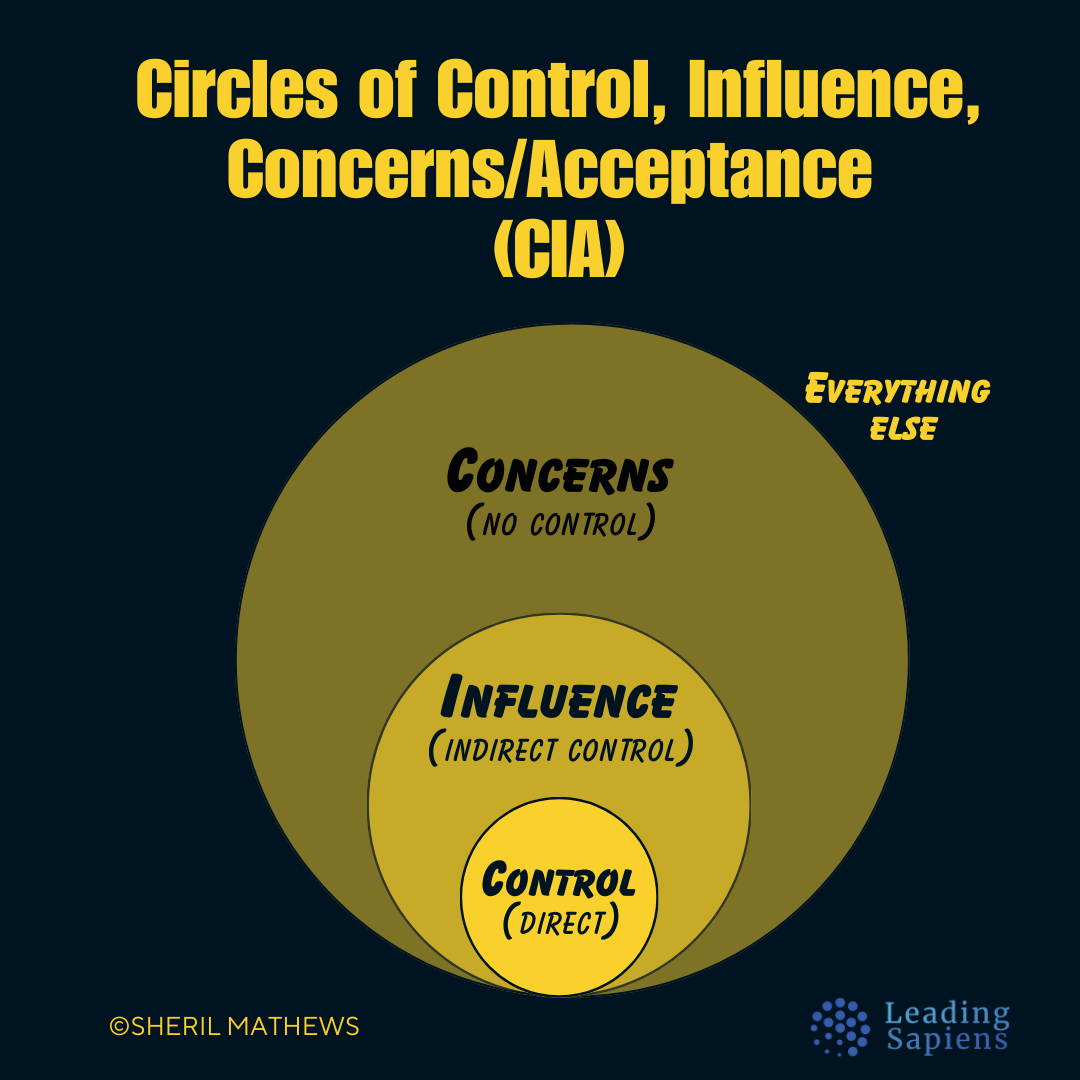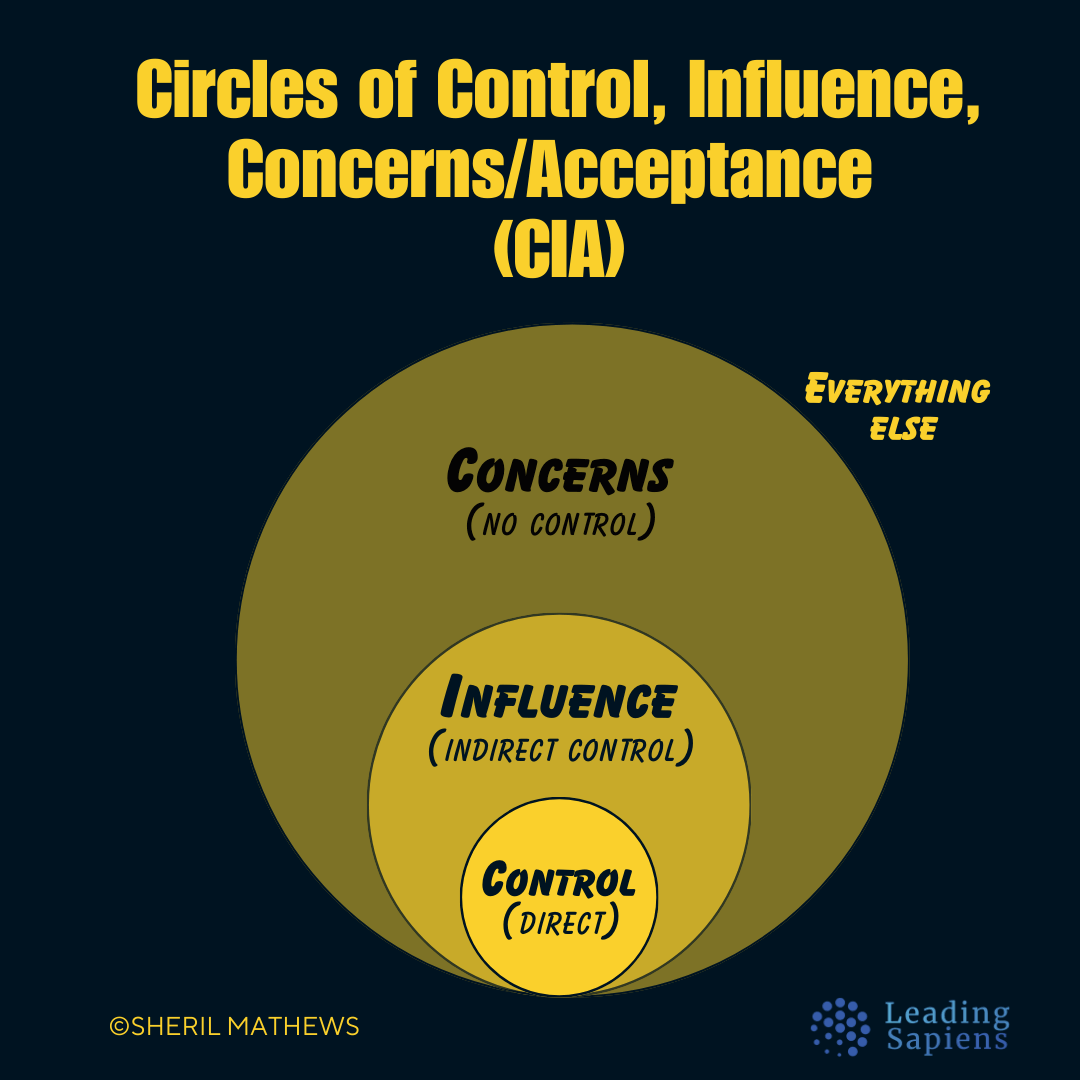How do effective leaders maintain their composure when everything seems out of control? They’re adept at discerning what they can control vs what they can’t, and what they can influence. The circle of control, influence, and concerns (acceptance) framework or CIA — is a “leadership triage” tool that helps focus on what you can actually change, rather than wasting time and effort on things beyond our control.
The vagaries of modern leadership
In my coaching practice, leaders (at all levels) often express a sense of helplessness. They might not put it that way, but it becomes evident from their words and actions.
I’ve highlighted the psychological concept of locus of control and how leaders influence it. The question is how do you move your locus of control from external to internal? Same for your teams?
Operating in uncertainty and a lack of control is inherent in leadership. The paradoxical nature of leadership means that the higher you go, the less you directly control, but you’re directly responsible for more.
Maintaining your sanity, let alone effectiveness, requires high self-awareness and a relentless focus on what’s actually in your control.
The Circle of Control, Influence, and Acceptance/Concerns (CIA) framework helps leaders stay grounded. Popularized by Stephen Covey in his 1989 classic "The 7 Habits of Highly Effective People," this model is a go-to in my coaching sessions.
The problems we face fall in one of three areas: direct control (problems involving our own behavior); indirect control (problems involving other people's behavior); or no control (problems we can do nothing about, such as our past or situational realities). The proactive approach puts the first step in the solution of all three kinds of problems within our present Circle of Influence.
Direct control problems are solved by working on our habits. They are obviously within our Circle of Influence. …
Indirect control problems are solved by changing our methods of influence.
No control problems involve taking the responsibility to change the line on the bottom of our face—to smile, to genuinely and peacefully accept these problems and learn to live with them, even though we don’t like them. In this way, we do not empower these problems to control us.
— Stephen R. Covey
The core idea goes back to the ancient Stoic notion of “dichotomy of control” or “the Stoic fork.” It’s not about gaining more control; it’s getting clear about what you truly control and influence, and where to direct your energy proactively.
Mastering this art of discernment is relevant for leaders because:
- By focusing on what you can control or influence, you maximize return on effort and minimize wasted energy.
- Accepting what's beyond your control frees up mental energy and reduces anxiety.
- Defining your spheres of control and influence leads to better strategic choices.
- Recognizing the limits of your control increases resilience in the face of change.
- People copy leaders, which helps create a culture of proactivity and personal responsibility.
Let’s examine each circle and how to implement them.

Circle of Control
The smallest innermost circle contains things we have direct control over, such as our thoughts, attitudes, actions, and how we choose to respond. These include:
- Your mindset and interpretation of situations.
- The words we use.
- Our decisions and choices.
- Daily habits, work ethic, and interactions.
- Skills you choose to learn and improve.
- How you prioritize and allocate your time and energy.
- Taking the smallest action that will move the needle.
- Making and keeping commitments.
Circle of Influence
The middle circle includes things we can influence but not directly control. For example:
- Your team's performance and motivation. You can influence it, but cannot directly control individual actions.
- Same for relationships with peers and superiors.
- You can influence culture but can't single-handedly change it.
- Overall market direction.
- Resource allocation in your department.
- Implementation of new processes or technologies in your area.
- You can influence customer satisfaction, but cannot control all factors affecting customer experience.
Circle of Concern (Acceptance)
This outermost circle of concern includes things we care about and that impact us but we can’t control or influence. Acceptance means taking responsibility while also acknowledging that there are people and situations we cannot change. By proactively choosing to accept, we disempower these factors from controlling us.
The porous boundary between our circles of influence and circle of concern/acceptance is where most of our problems originate.
This includes:
- Outcomes and consequences of our actions.
- External circumstances.
- Company-wide strategic decisions by top management.
- Market conditions affecting your industry.
- Budget constraints imposed from above.
- Organizational restructuring decisions.
- Unexpected crises or external events.
…in choosing our response to circumstance, we powerfully affect our circumstance. When we change one part of the chemical formula, we change the nature of the results.
— Stephen R. Covey
Jeff Bezos’ dictum of “disagree and commit” is a practical implementation of this idea. This is reflected in Amazon’s leadership principle of “Have backbone, disagree and commit”.
Example
Imagine your company is preparing for a merger.
Circle of Control:
- Your preparation for the changes (updating skills, networking)
- Managing your attitude towards the merger
- How you communicate changes to your team
Circle of Influence:
- Team morale during the transition
- The integration process between the two companies
- Retaining key talent in your department
Circle of Acceptance:
- The final decision on whether the merger goes through
- Choice of the new leadership team
- Global economic factors influencing the merger
By focusing on what you can control (your preparation, attitude) and what you can influence (team morale, integration process), you can navigate the uncertainty of the merger more effectively. At the same time, accepting what you can't change (the final merger decision) allows you to adapt more readily to whatever comes your way.
How do you differentiate between them? It comes through practice. Covey gives some clues:
One way to determine which circle our concern is in is to distinguish between the have's and the be's.
The Circle of Concern is filled with the have's"I'll be happy when I have my house paid off.""If only I had a boss who wasn't such a dictator.""If only I had a more patient husband.""If I had more obedient kids.""If I had my degree.""If I could just have more time to myself."
The Circle of Influence is filled with the be's --I can be more patient, be wise, be loving. It's the character focus.
— Stephen R. Covey
Circle of Control as an ongoing reflection practice
One way to improve is to integrate this tool into your regular reflection practice or when working with a coach.
- Periodically assess where you focus your actions and which concerns fall into each circle. This practice can provide clarity and direction.
- Focus on actionable steps within your control while developing strategies to expand your influence. Practice mindfulness and acceptance for what lies beyond them.
- When faced with a challenge, give yourself 24 hours to focus solely on your circles of control and influence before considering factors in your circle of acceptance/concern.
- Identify one area in your circle of influence where you'd like to have more impact. Brainstorm actions within your control to expand your influence.
- Choose one stressful item in your circle of acceptance. Practice mindfulness techniques to cultivate genuine acceptance of this uncontrollable factor.
- Use this framework in your 1-on-1 conversations so your team starts implementing it too.
Why is implementation so hard?
The framework is simple but nevertheless effective. However, it’s not easy to master overnight. Our default ways of operating actively work against it. Common challenges include:
- Our brains have cognitive distortions that interfere with objective assessment. For example, the negativity bias causes us to focus disproportionately on problems and threats, which frequently lie in our circle of concern. To make things worse, they cloud our judgment on what is in fact within our control and influence.
- Strong emotions, especially in high-stress situations, can cloud judgment and make it difficult to accurately categorize issues.
- Worry is a psychological mechanism that gives a sense of control over the uncontrollable. Breaking this habit requires consistent effort and mindfulness.
- Sometimes we mistakenly believe we have more control or influence than we actually do, leading to frustration and wasted effort. Conversely, we may not recognize the full extent of our influence, missing opportunities to effect change.
- Genuinely accepting things beyond our control is psychologically challenging, especially for driven, results-oriented leaders. The desire to control everything perfectly can make it hard to let go of things in the circle of concern.
- Taking the time to reflect and categorize issues can feel like a luxury.
To make it work, practice relentlessly until it becomes second nature to how you respond. This won’t happen quickly and will take diligent practice and commitment.
Additional pointers:
- By managing your circle of control, your influence will expand over time. Conversely, undue focus on the circle of concern without discernment leads to stuck patterns.
- Even very small wins in your circle of control can have far-reaching impacts on your circle of influence and beyond. Don’t assume you can predict that beforehand.
- Although counterintuitive, accepting what you can't control leads to greater influence and effectiveness. In the same vein, non-acceptance leads to wasted energy and unnecessary suffering.
- Things in your circle of concern often fall under someone else’s circle of control. Awareness of this fact increases your available actions.
- Your ability to maintain clarity and focus during crises or uncertainty is a competitive advantage and an essential aspect of effective leadership.
Circle of control and locus of control
Locus of control refers to the degree to which people believe they have control over the outcome of events in their lives. Working with this framework shifts the locus of control in the following ways:
- By focusing on the circle of control, leaders are reminded of their personal agency, which is the foundation of an internal locus of control.
- The Circle of Influence encourages leaders to see how they can impact outcomes indirectly. This reframing shifts the perception from "I can't control this" to "I can influence this," which is a more internal perspective.
- Circle of Acceptance isn't about passive resignation. It's about actively choosing to accept what can't be changed, which is an internal locus behavior.
Mastering the circles of control framework is an ongoing practice in your leadership journey. Each challenge presents an opportunity to refine your understanding and application of the principles.
It requires consistent self-reflection and a commitment to growth. As you become adept at discerning what you can control, influence, or must accept, you'll find yourself better equipped to lead effectively.
Related Reading
- Metacognition in leadership
- Changing mindset by taking action
- Role of doubt and confidence in leadership
- Leadership as choices and actions
Sources
- Covey, Stephen R. (1989). The 7 Habits of Highly Effective People.
- Conyers, M. A., & Wilson, D. L. (2015). Positively Smarter: Science and Strategies for Increasing Happiness, Achievement, and Well-Being.
- Bass, B. M., & Bass, R. (2008). The Bass Handbook of Leadership: Theory, Research, and Managerial Applications.
- Edmonstone, J. (2011). Action Learning in Health Care: A Practical Handbook.
- Achor, S. (2010). The Happiness Advantage: How a Positive Brain Fuels Success in Work and Life.


